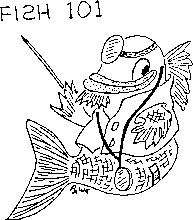
Dear Dr. Ghoti,
I have a pair of Convict Cichlids that spawn about once a month. They
are good parents and I’ve raised several batches to saleable size.
What am I going to do with all these fish? The local fish shop bought
a few of them for 25 cents each, but now they don’t want to buy any
more, even though they are selling them for $3 each.
---Crowded in Kirkland
Dear Crowded
The world doesn’t need any more Convict Cichlids. True, they are very
prolific and are great parents. This can be a lot of fun and be very
educational, but don’t expect to make money doing it. The fish shop
gave you 25 cents each because Convicts aren’t a big seller and will
require a lot of food and maintenance before they all get sold.
Retail shop space is expensive and Convicts don’t do a very good job
of paying the bills. Try some of the other shops in town. Try one of
the wholesalers. Don’t ask for a lot of money for these fish, in fact
you might consider just giving them away. You could bring some to the
aquarium society meeting; that’s what many of us do. Remember to
get your breeder’s award points [Ed: for more information about the
Breeder’s Award Program, ask at the meetings, or phone any board
member.]. Maybe it’s time to try breeding another species of
cichlid... one that is in demand and worth some money.
Dear Dr. Ghoti
I just bought some fish called X-Ray Tetras
but they aren’t in
any of my books. The aquarium shop doesn’t know their scientific name
or why they are called X-Ray.
---Mr. X
Dear Mr. X,
The name X-Ray tetra was originally coined to describe the
blushing
variety of the Pristella tetra (Pristella
riddelei) in which the fish appear somewhat transparent due to a
genetic lack of silver pigments. The name was such a catchy one that
it is now used for the normally colored variety as well. This is a
really nice, peaceful and hardy little fish. Used to be you could get
albinos as well, but I haven’t seen any of those for a long time.
Dear Dr. Ghoti,
I was just reading about that Killifish that Dave Sanford brought to
the November meeting. It is called \emph{Nothobranchius rachovi}, the
fire Killie. But in some books the name is spelled \emph{N. rachovii}
and the fish was originally named after Arthur Rachow. So shouldn’t
the name be \emph{Nothobranchius rachowi}? Also, why are they called
Killifish
?
---Puzzled in Puyallup
Dear Puzzled,
You got me. I’m clueless. Maybe someone out there will respond to
our editor with some answers.
Dear Dr. Ghoti,
I keep having problems with Ich in my tanks. What is the best treatment?
---Ichy in Issaquah
Dear Ichy,
Ichthyophthirius multifiliis (Ich) has evolved into more
virulent strains in the last ten years. The key to dealing with an
Ich infestation is to identify it in the initial stages. The term
flashing
is used in aquaculture to describe a type of behavior of
pond fish in which they try to rub parasites of their skin by turning
sideways and swimming along the substrate. This type of scratching
behavior can be observed in the aquarium fish as well, and is always a
cause for concern. Another symptom of parasite infestation is clamped
fins and/or labored efforts at swimming or breathing. Once you see
the characteristic white spots of Ich you need to take quick action.
My first choice in medications for Ich is Maracide (by Mardell). Used according to directions (for the recommended period of time, or longer if necessary) it is an effective treatment and safe for all species of fish. Be sure to shake the container throuroughly each time it is used because some of the chemicals involved have a tendency to settle to the bottom.
Another good treatment for Ich is a combination of Malachite Green and Formaldehyde (both dangerous chemicals). Products such as Formalite and Quick-cure contain this combination. Some groups of fish, such as Cichlids, livebearers, and anabantids, can be treated with up to twice the recommended dosage, but I’m not endorsing that practice here.
Some other treatments are Quinine compounds, methylene blue, and copper compounds. I don’t like copper much because it can be dangerous and hard to administer; its toxicity and efficacy depend on the water chemistry. Yet, I’ve had some pretty good results using the chelated forms such as Coppersafe. I like methylene blue because it is so mild and can be used on very young or sensitive fish in relatively high concentrations. It’s not a very strong cure, however.
Speeding up the treatment is an important consideration because Ich is
very resistant to chemicals when it is in the white spot
stage,
embedded in the skin of the fish. Raising the temperature can speed
up the cycle, and a light sprinkling of aquarium salt over the gravel
of the aquarium is thought to help eradicate some of the dormant
forms of the parasite.